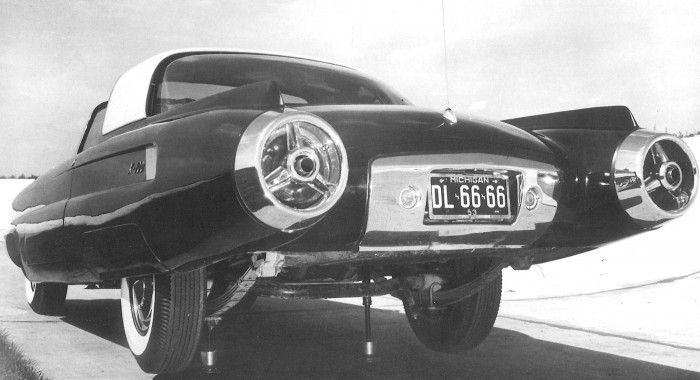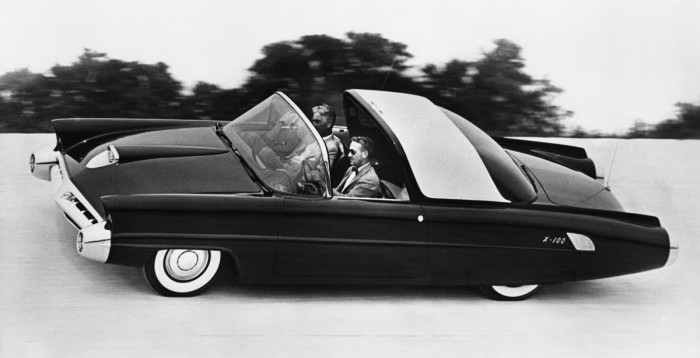The car with the most gadgets: Lincoln X-100 could’ve become the Continental
Posted on Jul 22, 2016 in Featured | 2 comments

Photos courtesy The Henry Ford, except where noted.
According to one estimate, more people saw the Lincoln X-100 concept car than any other Ford concept car before or since. Ford trotted it out just about anywhere it could: dealership openings, freeway openings, ice cream stand openings, you name it. But that was during the mid-1950s, when the car was new, and while The Henry Ford has had it on display for many years since then, the museum has decided to continue the tradition of maximum exposure for the car by showing it at this year’s Keels and Wheels concours.
Discounting a number of experimental cars and Edsel Ford’s hot rods—which might have gone on public display but were built primarily for his personal use—the X-100 represents Ford’s first proper concept car as we recognize them today. It previewed styling cues for future production models; it wowed the crowds at various auto shows; and it boasted whiz-bang technology that seemed to come from the far-flung future. And it wouldn’t have come about if it weren’t for Ford’s rivalry with General Motors.
As Jim and Cheryl Farrell relate in their book Ford Design Department Concept and Showcars, 1932-1961, the X-100 got its start in about 1949 with designer Joe Oros, who had heard from some former GM designers that the company was working on multiple high-technology concept cars—cars that would eventually be revealed in 1951 as the LeSabre and the XP-300. More pressing, though, Oros, who was working on the 1952 Ford’s design at the time, desperately wanted to use the big round jet exhaust-like taillamps that Advanced Studio designer Gil Spear had used on the Cutlass, one of several 3/8-scale clay styling models he created for Ford in the late 1940s. Oros believed those taillamps could become a design hallmark for Ford and that the best way to keep other companies (like GM) from using it was to debut it on a concept car first.
Oros got his way and his boss, George Walker, assigned him the project, working out of the Lincoln studio. He took the rear third of the X-100 almost straight from Spear’s Cutlass, but reworked the rest of the car’s design to include a retractable clear roof section and its hooded headlamps over a protruding front bumper.

Photo via Ford Media.
According to the Farrells, word about the X-100 got around the Ford executive offices as it took shape, and even Henry Ford II stopped by to examine it while it was still in progress, believing the car had the potential to become the next Lincoln Continental. To that end, the studio renamed the car the Continental 195X. Though based on a 1952 Lincoln chassis and drivetrain, the Continental 195X featured a number of advancements under the skin, including a de Dion-style independent rear suspension, power brakes and power steering, and a 1952 Lincoln Y-block overhead-valve V-8 with five carburetors on a “Multi-plex throat” intake manifold: one central four-barrel carburetor and four additional two-barrel carburetors around the four-barrel. The Continental 195X also used Firestone radial-ply tires, reportedly making it the first Ford vehicle to use radials.
Ford introduced the Continental 195X in January 1952 at the Chicago Auto Show as a pushmobile, possibly with a fiberglass body and certainly with Continental badging on it. And though Henry Ford II championed the car as the next Continental, his brother, William Clay Ford—whom Henry Ford II tasked with the Continental Mark II project—found that potential Continental buyers preferred a more formal design.
Not to let all that work go to waste, Ford renamed the car the X-100, removed the Continental badging, and assigned engineer Hiram Pacific the task of making it a fully functioning car. That meant not only tuning the quintuple-carbureted Y-block to run properly, but also getting all of the promised geegaws working. In addition to the power retractable top section—which would close automatically when it began to rain thanks to a water sensor mounted to the roof—the X-100 also featured built-in hydraulic jacks, heated seats front and rear, memory power seats, power hood and trunk lid, hot and cold windshield washer sprays, a center console with a telephone and dictaphone and an electric shaver, and thermostatically controlled fans to cool the front brakes.

All the gizmos and the revamped steel body not only added a severe load to the electrical system but also plenty of weight overall. Pacific upgraded the car to 12 volt with circuit breakers to handle the electrical load and had to have the tires specially made and many extra gussets placed in the frame to handle the car’s 6,300 or so pounds.
But work it did when Ford re-debuted it as part of the company’s 50th anniversary celebrations in the summer of 1953. That fall, Ford then shipped it to Europe for the Paris Auto Show, the Earl’s Court Auto Show, and the Bonn and Köln auto shows. Around the end of the year, it returned to the States and spent the next year and a half touring the country, stopping by at dealerships, shows, fairs and any other opportunity for publicity. It even co-starred with Lauren Bacall in the 1954 movie Woman’s World. What’s more, the Farrells note, it drove to all of those appointments in Europe and the United States, accumulating more than 12,000 miles in the process.

Ford took the X-100 off the show circuit in February 1955 and officially retired it a couple years later then in 1958 gave it to The Henry Ford, where it has remained ever since. In the 1990s it appeared twice at the Pebble Beach Concours and once at Meadow Brook, and more recently it appeared as part of a dream cars display at the Heritage Museum and Gardens in Sandwich, Massachusetts.





The later T-Birds certainly were inspired by this concept car! This car is quite a bit larger,but the look is there for sure.
Imagine the look on the service techs face at a dealership, lifting off the air intake to reveal 5 carburetors.
I know plenty of people who are scared of tuning just one 2 bbl.
Would be great to see a photo of all that plumbing and linkage!